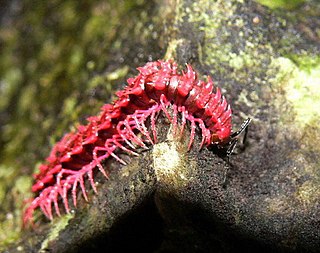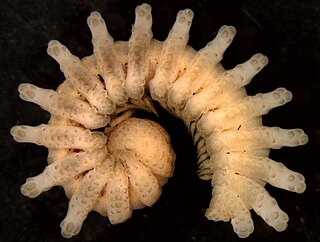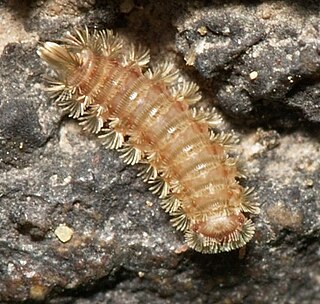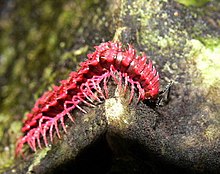
Desmoxytes purpurosea also known as dragon millipede, is a spiny and toxic millipede named for its vivid pink color. It was formally described in 2007 from a specimen collected at the Hup Pa Tard limestone cavern in the Uthai Thani Province of Thailand. Among the largest species of its genus, the adult millipede is approximately 3 cm (1.2 in) long. It lives in the open on leaf litter. Large numbers of them occur after rain showers. The millipede has glands that produce hydrogen cyanide to protect it from predators, which causes it to smell like almonds. Its toxicity is advertised by its aposematic color.
Desmoxytoides hasenpuschorum is a species of millipede and the only species in the monotypic genus Desmoxytoides. It lives in Australia. This species is closely related to the dragon millipedes of the genus Desmoxytes, and there is some speculation, even by Robert Mesibov, the genus authority, that the split may not be necessary. While Desmoxytoides hasenpuschorum is similar to the millipedes of Desmoxytes in paranotal form and metatergite sculpture, it has a simpler gonopod telopodite with an unprotected solenomere which gives it its own monotypic genus. This species has the ability to produce hydrogen cyanide to ward off predators.

Polydesmida is the largest order of millipedes, containing approximately 3,500 species, including all the millipedes reported to produce hydrogen cyanide (HCN). Polydesmids grow and develop through a series of moults, adding segments until they reach a fixed number in the adult stage, which is usually the same for a given sex in a given species, at which point the moulting and the addition of segments and legs stop. This mode of development, known as teloanamorphosis, distinguishes this order from most other orders of millipedes, which usually continue to moult as adults, developing through either euanamorphosis or hemianamorphosis.
Hylomus is a genus of millipede of the family Paradoxosomatidae found in southeast Asia.

Eutrichodesmus is a genus of millipedes in the family Haplodesmidae, containing at least 32 species in China, Taiwan, and Southeast Asia. One of these species exhibits sexual dimorphism in segments number: The adult females have 20 segments, but the adult males have only 19.

Polyxenida is an order of millipedes readily distinguished by a unique body plan consisting of a soft, non-calcified body ornamented with tufts of bristles – traits that have inspired the common names "bristly millipedes" or "pincushion millipedes". There are at least 86 species in four families worldwide, and are the only living members of the subclass Penicillata.

Orthomorpha is a genus of millipedes in the family Paradoxosomatidae containing approximately 50 species distributed in Southeast Asia.

Sinocallipus is a genus of predominantly cave-dwelling millipedes in the order Callipodida. Five of the six known species are found in limestone caves on the Indochinese Peninsula from Vietnam to southern China, and it is the only callipodidan genus entirely confined to the tropics. Individuals range from 40–70 mm (1.6–2.8 in) long and possess 55 to 70 segments. Sinocallipus is the sole taxon of the callipodidan suborder Sinocallipodidea, and thought to be the most primitive and sister group to all other callipodidans. In contrast to many other millipede groups, the gonopods of Sinocallipus show little variation between species, while other characters such as color, size, and other body parts differ more noticeably between species.

Orthomorpha coarctata, the long-flange millipede, is a widely introduced species of Polydesmidan millipede of the family Paradoxosomatidae. It is presumed native to Southeast Asia but due to transport by humans occurs in tropical and sub-tropical areas throughout the world, including the Hawaiian Islands, the West Indies, Gulf Coast of North America, and the Galápagos Islands.

Casimir Albrecht Willem Jeekel (1922–2010) was a Dutch myriapodologist and entomologist known for his major contributions to the taxonomy of millipedes. His 1971 monograph Nomenclator Generum et Familiarum Diplopodorum is credited as launching the "modern era" of millipede taxonomy, and has been considered the "most important single work ever published on the Diplopoda". He served as director of the Zoological Museum Amsterdam, and authored over 150 works on the taxonomy of millipedes and other myriapods.

Haplodesmidae is a family of millipedes in the order Polydesmida. Species occur in East Asia, Southeast Asia, and Oceania, although some species have been introduced to the New world tropics. Species are small bodied, often with elaborate sculpturing on the tergites, and some species are capable of rolling into a near-complete ball.

Ammodesmidae is a family of small millipedes endemic to Africa, containing seven species in two genera. Ammodesmids range from 1.4 to 5.0 mm long with 18 or 19 body segments in both sexes, and are capable of rolling into a tight sphere.
Hylomus rhinoceros is an aposematic species of dragon millipede in the family Paradoxosomatidae. It is only known from Champasak and Sekong Provinces in southern Laos.
Hylomus rhinoparvus is a species of dragon millipede in the family Paradoxosomatidae. It is only known from Houaphanh Province of northeastern Laos.

Chamberlinius is a genus of flat-backed millipedes in the family Paradoxosomatidae. There are five species; 3 of which occur only Taiwan, one only in the Ryukyu Islands of southeast Japan, and one occurring in both areas. Individuals are 25–37 mm (0.98–1.46 in) long and up to 5.5 mm wide, colored in pale yellow to brown, sometimes with dark brown markings on the anterior portion of body segments.

Anoplodesmus saussurii is a species of millipedes in the family Paradoxosomatidae. It was once thought endemic to Sri Lanka, but it was later found in Fiji and Mauritius.

Desmoxytes planata, is a species of millipedes in the family Paradoxosomatidae. It is a pantropical species with a vast distribution due to human interference in transportation. It is native to Andaman Islands and introduced to Thailand, the Seychelles, Java, Sri Lanka, Fiji and probably in Malay Peninsula.
Tonkinosoma tiani, is a species of millipede belonging to the family Paradoxosomatidae. It is found from caves in southern China.

Desmoxytes cervina, is a species of millipede in the family Paradoxosomatidae. It is known from Myanmar and Thailand.

Desmoxytes golovatchi, is a species of millipede in the family Paradoxosomatidae, that can be found in Thailand.














